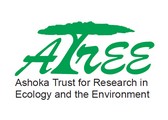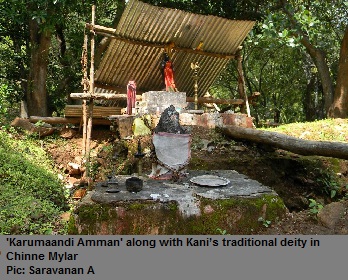Any and all opinions expressed in this newsletter are solely those of the author(s) and do not reflect the opinion of ATREE.
Centre for Excellence in Conservation Science
Royal Enclave,Srirampura,Jakkur Post
Bangalore-560064
Telephone: 080-23635555 (EPABX)
Fax : 080- 23530070
As a part of a larger study which required
interactions with the 'Kanis', an indigenous
tribe found in the Agasthyamalai region, I
began taking a personal interest in observing
the inherent religious processes, structure
and functions. My first encounter of a unique
Kani religious symbol was just a few well kept
stones that lay decorated in the fringes of
Injikuli, by the banks of Tamirabarani.
Instinctively, I assumed homogeneity in
religious symbolism represented by the
neatly arranged stones of Injikuli across the different Kani settlements inside KMTR.
However, with continuous interactions over
four years I understood that even for a small,
homogenous and isolated population with a
seemingly static societal norms, the
trajectory of religion was a dynamic one,
undergoing rapid change, transformation
and metamorphosis. Today the Kanis, apart
from sustaining age old practices of offering
their land produce during Karthige month at
Kodethi just outside Periya Mylar, have also
started incorporating rituals and totems generally associated with mainstream
religions. For example, there is a statue of
'Karumaandi Amman' a deity of another
dominant community of the landscape in the
Kani sacred site in Chinna Mylar. In Servalar,
the Kanis' participation in the annual festival
of the Sangili Boothathar temple was not too
common about a decade ago. Interestingly
this temple was built by the labourers who
had come from the plains during the
construction of Servalar dam. In addition to
such rituals, there have been Christian
evangelists who preach to the Kanis
intermittently and find a substantial audience
in them. A few families in Servalar and about
fifty per cent of the population in
Agasthyamalai Kani Kudiruppu now follow a
certain sect of Christianity. Though they do
not have a religious site inside KMTR,
frequent meetings are held in one of the
‘believers’ houses. Though the Kanis follow
varied religions, old community practices are
still retained and often combined with newer
ones they are beginning to adopt. Yet, there
seems to be an inner urge among the Kanis
to identify themselves with the larger section
of the society. Though it may not have
conservation significance, it would be
interesting to study why the Kanis feel the
need to merge or associate themselves with
the mainstream identities.
Editorial Team
Editor: Allwin Jesudasan
Associate editor: Rajkamal Goswami
Editorial Review: R. Ganesan, M. Soubadra Devy, T. Ganesh
Design and presentation: Kiran Salegame
A S H O K A T R U S T F O R R E S E A R C H I N E C O L O G Y A N D T H E E
N V I R O N M E N T
If you have any suggestions or comments please let us know through the boxes below






